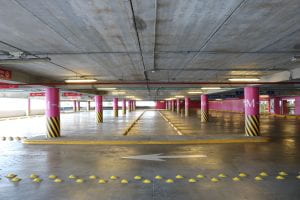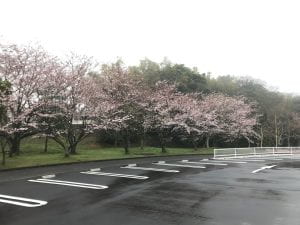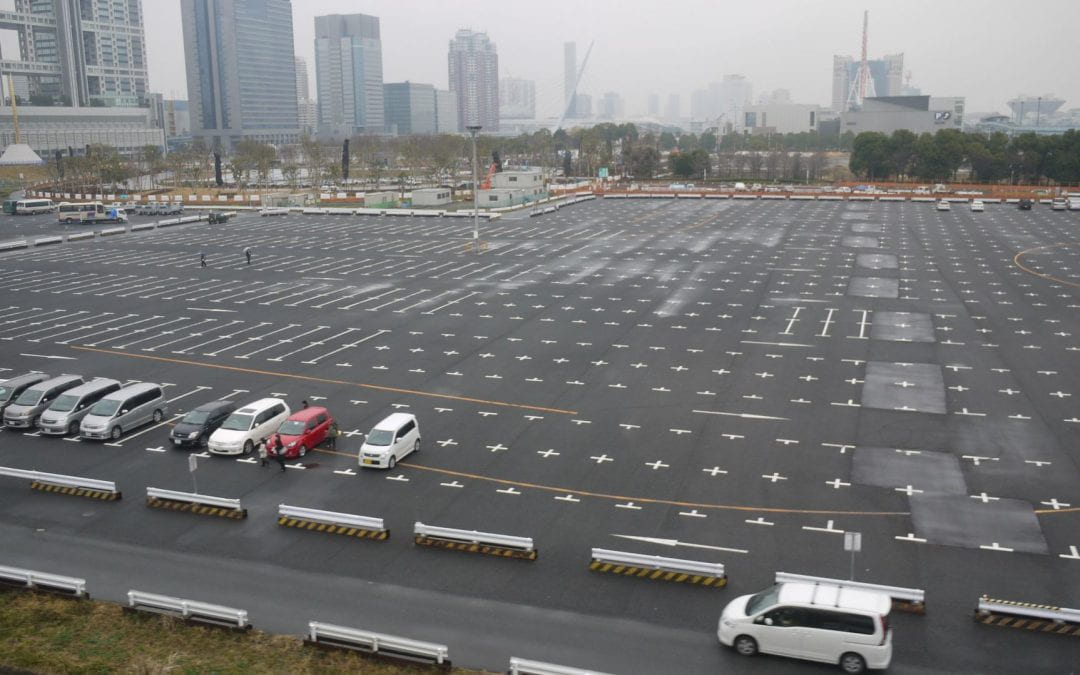In urban environments, parking infrastructure has become so ubiquitous that it often fades into the backdrop of our daily lives. Yet its omnipresence masks a deeper environmental dilemma. These vast expanses displace ecosystems and shrink biodiversity, and are primarily made of heat-absorbing, impervious materials. Addressing these concerns about parking infrastructure will play a pivotal role in shaping the environmental health of our cities.
When parking lots are created using dark colored materials, most commonly asphalt, they absorb heat, exacerbating what is known as the urban heat island (UHI) effect. UHIs occur when natural surfaces are replaced with manmade infrastructure, such as parking lots, in a concentrated area. An abundance of surfaces that retain heat leads to hotter temperatures in urban areas. To demonstrate just how drastic this effect can be, a group of researchers reported in Urban Forestry and Urban Greening that the temperature of the surface of one parking lot at noon on a summer day was 59 degrees F hotter than that of a nearby grassy field. The same researchers also found the air temperature immediately above the lot was 35 degrees F higher than the field. These “islands” of heat lead to greater energy use for things like air conditioning and increased risk of heat related illnesses.
In a literature review of UHI island effects, researchers summarized the data of multiple studies and concluded that any type of building, averaged out, requires 12% more cooling energy compared to surrounding rural areas. Quantified another way, another group of researchers aggregated data from fifteen studies to see just how much pressure UHI was putting on electricity usage. Their review found that for every increase in one degree of air temperature, there is a 0.5%-8.5% increase in electricity demand. As climate change exacerbates the UHI effect, this energy usage will only increase. As that demand expands, more power plants will be required to fill in the gaps.
These increased temperatures create dangerous environments for humans. People living in urban spaces are far more likely to experience heat-related deaths than people in rural areas. Studies have revealed this risk can be as high as 30% more likely in some urban environments. That figure results in around 1,500 deaths per year, surpassing the number of fatalities resulting from any other severe weather events. Mortality is the most tragic effect of UHI, but there are other negative health effects, too, including “heat strokes, dehydration, loss of labor productivity, and decreased learning.”

While urban spaces experience more negative UHI health outcomes than rural spaces, these effects are experienced disproportionately within cities themselves. Those over the age of 65 are especially vulnerable, and make up 39% of heat related deaths. In New York City, researchers found a significant correlation between over 65 heat-related deaths and the experience of “poverty, poor housing conditions, lower rates of access to air-conditioning, impervious land cover, surface temperatures aggregated to the area-level, and seniors’ hypertension.” This suggests it is not just age that harms people’s ability to handle high heat, but compounding factors that aggravate their chances of resilience.
Additionally, the “[p]ercent Black/African American and household poverty were strong negative predictors of seniors’ air conditioning access in multivariate regression analysis.” In alignment with that finding, research indicates that previously redlined areas have far higher land surface temperatures compared to non-redlined areas. These conclusions suggest historical housing policy is strongly related to current disproportionate UHI effects. Similar conclusions about inequitable heat-related illness and death have been drawn repeatedly by researchers. Considering that parking lots comprise 5% of all urban space, their contribution to the UHI effect is substantial. Alternative construction with sensitivity to those who may endure the brunt of UHI effects could significantly reduce the role parking lots play in creating more urban heat.
The materials used in parking lots absorb or reflect heat, but they are also frequently impermeable. The permeability of a parking lot surface determines where rainfall will go when it runs off of that surface. When the chosen material is impervious, water cannot seep into the ground and instead runs along it, collecting in bodies of water or low-lying areas. To increase the longevity of asphalt parking lots, coal-tar based coats are frequently applied. While this intensifies the runoff effect, it also acts as a pollutant. These coatings contain polycyclic aromatic hydrocarbons (PAHs), a toxic class of chemicals that harm aquatic life and are a suspected carcinogen to humans. Over time, these coatings are worn away and rainwater carries the chemicals to bodies of water. A study conducted on 40 large urban lakes across the U.S. found that coal-tar based coats on parking lots were a major source of elevated PAH levels in those water bodies.
Polluted runoff is not the only water trouble, either. Impervious surfaces increase the likelihood that an urban space will flood. One study in Geographical Research Letters used a novel model to explore how much cause-and-effect occurs between impervious cover and flooding. The researchers observed the same spaces over a stretch of time and used panel regression to control for confounding variables like regional weather events or topography. They measured flooding events while recording the increasing amount of impervious surfaces present in a given year. Their overall finding was that for every 1% increase in impervious surfaces, the rate of annual flooding magnitude increased by 3.3%.

The ever-expanding growth of parking structures also leads to the displacement of natural ecosystems. In an analysis of ecological conditions in the United States, researchers created a habitat condition index “that integrates quality and quantity measures of habitat.” They discuss how the quantity of habitat space is decreased by parking lots. Equally as troublesome is that when parking lots are constructed, the quality or functionality of habitats surrounding them also decreases. This negative consequence is not only bad for ecosystems themselves, but for humans that benefit from environmental services. Soil and plants retain water, which reduces runoff, provides shade that brings down the air temperature, stores carbon, and produces oxygen. Insects may pollinate food crops and animals may be a source of tourism. These are just some of the ecosystem services humans enjoy. As habitats decrease due to parking lot sprawl, so too does the ability to create these benefits.
In a case study of how urban heat islands, impermeable surfaces, and ecosystem services intersect, researchers looked at the effects on fish in North Carolina rivers. They found darkly colored parking surfaces heat up rainwater as it runs along the surface. This warm water then collects in low-lying cold water streams hosting trout and salmon habitats. The scientists claim that increased water temperatures will negatively impact the fish’s chance of survival and may even cause mortality. Not only is this disruptive to ecosystems but it can even impact tourism states that offer fishing and wildlife viewing.
Underground garages can sometimes mitigate the environmental problems posed by above-ground lots. However, they come with their own health risks. Underground parking lots have worse air quality than urban air. Pollution in garages is undoubtedly due to car emissions, however, the lack of ventilation intensifies the problem. Increased levels of carbon monoxide and nitric oxide are found in garages, and these pollutants can negatively impact cardiovascular and neurobehavioral systems. While short-term visits to parking garages may not be a huge concern, those who work in them or store their vehicles in them have much higher exposure to these chemicals. Therefore, in considering garages as an alternative to above-ground lots, construction should still be mindful of unwanted health outcomes.

Considering all the environmental problems associated with parking lots, the vast acreage currently and continuously dedicated to parking lots demands scrutiny. Other articles from this series consider how historically, the U.S. has required parking minimums based on limited data. This mismatch of demand versus supply has led to an overabundance of parking despite public perception tending to assume the opposite. A forthcoming article will consider issues of perception and the enabling conditions that will facilitate the implementation of land use tools to address the parking problem.
Luckily, local municipalities have the capacity to address these issues. They can yield their land use authority to design code to prevent or reuse unnecessary parking infrastructure. Creative alternatives may include shared parking to meet minimum requirements for buildings, or the conversion of unused parking lots into housing.
However, if the development of parking lots continues, it must be done using materials that are less disruptive to the environment. These alternatives may include installing light-colored surfaces to reflect sunlight and reduce UHI effect, using permeable materials to mitigate flooding and runoff, and incorporating vegetation into lots to increase ecosystem services. Some cities have successfully incorporated one more of these alternatives into their local code.
This article is part of a series from the Land Use Law Center that explores how local governments can implement Climate Resilient Development (CRD) as defined in the Sixth Assessment Report of the IPCC. CRD requires innovative reform of land use planning and regulation by local governments, The series presents and analyzes numerous local laws and policies capable of adapting to and mitigating climate change to create equitable and sustainable neighborhoods, achieving “sustainable development for all.”

